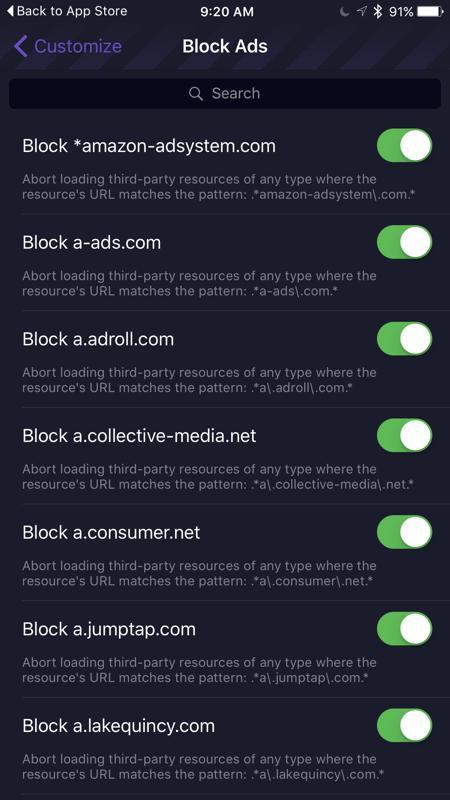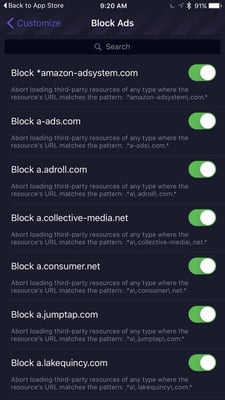Here’s What You Need to Know About Ad Blocking in iOS 9

In case you have been out of the tech loop, Apple released its new iPhone and iOS 9 operating system two weeks ago. In addition to more fine-tuned features like better navigation in Apple Maps, more built-in apps, and new emojis (finally, the taco!), the new operating system will now allow users to install ad blocking apps. This means users can now easily block third-party scripts, pop-up ads, trackers, and other forms of advertising that could come through.

Of course, ad blocking apps aren’t a novel idea. So what’s the big deal?
This is the first time that every iPhone user is allowed to use them in the mobile Safari app. Given that use of Safari makes up more than half of all mobile internet usage, let’s dive deeper into how ad blockers really affect websites and, more importantly, what this means for your digital marketing.
What do ad blockers block?
Each app has different specific content that it blocks, but most block the more outright “in-your-face” ads like pop-ups and banner ads. However, Google Adwords ads are often left out by many ad blockers because they either pay to show up or they’re seen as more helpful to users than other ads. Keep in mind that the iOS ad blocking apps only block ads in Safari, not inside applications – so if sponsored Facebook posts are part of your marketing strategy, a user scrolling through his or her news feed on the Facebook app will still see your ad.
How could this affect my website?
User experience
Some ad blockers don’t replace blocked content with anything else, meaning that a website could look like it’s missing content, images, or, in the case of Sears and the ad-blocking app Crystal… everything. See below: the screenshot on the left is the Sears website without any ad blockers on. The screenshot on the right is with ad-blocking app Crystal enabled. Not good.
Analytics
 A lot of ad blockers for iOS 9 block third-party scripts in addition to advertisements, so this could mean greater difficulty gathering the data that we need as marketers. A visitor to your site using Safari with a script blocker installed won’t appear in your analytics. So even though your website could work 100% fine for the user, you could still be missing out on important marketing information.
A lot of ad blockers for iOS 9 block third-party scripts in addition to advertisements, so this could mean greater difficulty gathering the data that we need as marketers. A visitor to your site using Safari with a script blocker installed won’t appear in your analytics. So even though your website could work 100% fine for the user, you could still be missing out on important marketing information.
What can I do as a marketer?
1. Look at the performance of your ads.
If ads are a large part of your marketing strategy, it’s important to take a hard, honest look at how well they’re actually working for your business efforts. It might bode well for you to be a bit more critical in their true success, especially if your target audience would be the type to use ad blockers (e.g. tech-savvy millennials or gamers).
Do some research for more insight into how your customers feel about your ads. Try a survey, or look more closely at their behavior on social networks to give you more of an idea. Bottom line, make sure your ads are actually making you money.
2. Ensure that your ads are actually being seen.
Even before iOS 9 was rolled out, a study from the Association of National Advertisers found that nearly a quarter of “people” watching online video ads and more than one in 10 display ads are actually robots. Yikes. What can you do?
If you’re advertising on Google, check out the Google Display Network. It can help let you know how many of your ads are actually being seen by real people not robots. If you use display advertising, you should also take this approach – make the ability to view the ads an absolute necessity.
3. Place more focus on a holistic inbound approach.
Choose more advertising methods that incorporate an inbound marketing approach, like advertising on Facebook and LinkedIn. Facebook is now encouraging marketers to advertise their content in a more natural way that doesn’t “feel” like an ad. LinkedIn’s new Sponsored Updates allow users to reach a broader audience than just their followers and promote content that’s actually relevant to that audience. Remember, since the new ad blockers only block advertisements and scripts in Safari, you should put more money in native advertising in specific network applications like Twitter, Facebook, LinkedIn, and Instagram.
Going one step further, ramp up organic traffic to your website by bulking up your website’s content and blog posts. Each new blog post is one more indexed page on your website, which means one more opportunity to show up in search engines and drive traffic to your website.
It is more important than ever to be mindful of where you as a marketer place your ads. If you have any questions about how these changes could affect your digital marketing strategy, feel free to get in touch with us, and we can walk you through some beneficial plans of action.

October 6, 2015
